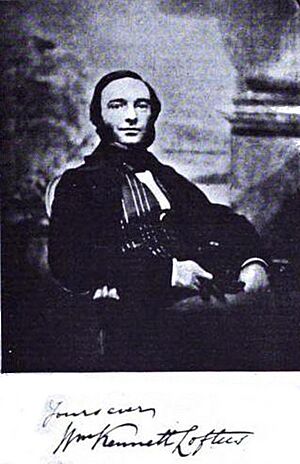William Loftus (archaeologist) facts for kids
William Kennett Loftus (born November 13, 1820 – died November 27, 1858) was a British scientist and explorer. He studied rocks, plants, and animals, and was also a famous archaeologist. An archaeologist is someone who digs up old cities and objects to learn about the past. William Loftus is best known for finding the ancient Sumerian city of Uruk in 1849.
Contents
Who Was William Loftus?
William Loftus grew up in Rye, a town in East Sussex, England. He went to school at Newcastle Royal Grammar School. Later, in 1840, he went to Caius College at Cambridge University. There, he studied geology, which is the study of Earth's rocks and soil. In 1845, he married Charlotte Thulbourne.
Exploring Ancient Lands
In 1849, William Loftus joined a special team. This team was called the Turco-Persian Boundary Commission. Their job was to map the border between what are now Iran and Turkey. Loftus worked as a geologist and naturalist for this group. This meant he studied the land, plants, and animals.
This work gave Loftus a great chance to visit very old places. In 1850, he and his friend Henry Adrian Churchill spent a month digging. They explored the ancient cities of Uruk (also known as Warka) and Larsa (also known as Senkereh). During this time, they found the famous Ziggurat of Ur, a huge temple tower.
Discoveries in Susa and Nineveh
For a short time in 1851, Loftus worked for the British Museum. He dug at a site called Susa, an ancient city in Iran. Later, another archaeologist named Hormuzd Rassam took over. Loftus and Rassam then worked together to explore more sites and write a report about their findings at Susa. Loftus is known for finding the Apadana there. This was a large hall with many columns, part of a royal palace.
In 1853, a new group called the Assyrian Excavation Fund hired Loftus. He went back to Uruk and worked there from January to April 1854. He uncovered a special wall made of colored clay cones. He also found some clay tablets with cuneiform script on them. Cuneiform was one of the earliest forms of writing.
Later that year, in October, Loftus moved to Nineveh, another ancient city. He also worked at Nimrud. In February 1855, he found the "Burnt Palace" of the Assyrian king Assurnasirpal II. Inside, he discovered many beautiful ivory carvings. He also did some digging at a place called Tell Sifr in 1854.
Later Life
In 1856, William Loftus started working as a geologist in India. But his health became poor while he was there. He decided to sail back to Britain. Sadly, he died at sea during the journey, when he was only 38 years old.
William Loftus's Books
William Loftus wrote about his amazing travels and discoveries.
- Travels and Researches in Chaldaea and Susiana in 1849-52 (1857)
- Reports of the Assyrian Excavation Fund I and II (published later in 1976)


